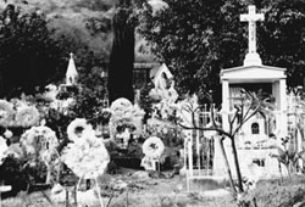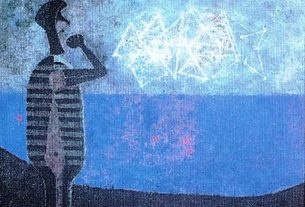High on a mountain, the isolated ranch house, serene, silent sentinel of the past, overlooks the vast sun-drenched Sayula Valley. Far below a railroad cleaves a fretted path through the town of Zacualco where a monumental sculptured head of Emiliano Zapata reminds one of restless angry days of the Revolution.
Guardian of history, the ranch house has given undisputed refuge to many, renegade and lover alike, for 150 years. Artesian water surfaces wondrously in the huge well that gives the ranch its name, EL POZO (The Well), and it’s here that many have lingered to quench their thirst and bathe.
Memory is lost of the ones who built the original single story stone house. Tentacles of vines now encroach on the red tiled porticoes that offer generous shade on all four sides to human, bird, reptile, insect and animal. It can be found far up the high-reaching trail, two hours distance from the nearest habitation. Gun slots speak eloquently of confrontation in turbulent times and the need for safety. Yesteryear’s happenings at EL POZO, but fleeting moments, are becoming misty, claimed by the cataracts of time. Only a few remain.
In the 1920’s Padre Tito, a Jesuit priest and distant cousin of a local family in San Pedro Tesistan, which was then only a ranch, administered clandestinely at EL POZO to a cluster of people craving spiritual nourishment. They gathered secretly and reverently, weathered, hard-working men with hats in hand, their women shrouded in rebozos. Once-a-month, during the Cristero Rebellion, the conflict between Church and State, Padre Tito gave communion, married, and baptised at great peril to his life. His muzzle loading old rifle stood near the make-shift altar. A niche in a thick wall of the house, capped by a volcanic stone, concealed the simple accouterments for celebrating mass. Until his recent death at the age of 102, Don Pablo who assisted Padre Tito in performing the sacraments, used to hold forth on village corners on the way it used to be.
Adolfo, said to be hiding from the law for having killed a man, spent a few years at EL POZO tending a herd of goats. Whatever the other circumstances, he was a kind and gentle and seemingly content with his solitude. His infrequent visits down to the village were to sell goat cheese and purchase basic provisions to supplement his hunting and small corn crop. When his desire came to move on, he disappeared without a trace.
Frayed dusty ropes, still hanging from a beam where a cradle had swung in the cooking room, evoke the memory of Lupe and Jorge, the most recent occupants. The house must have smiled to hear laughter and singing and sounds of love once again mingle with the timeless rhythm of restless wind. As newlyweds they were completely enamored with life and each other and sought to make their marriage ideal, one with nature as in olden days. The sweet fermenting smell of silage perfumed the polished clear air and melded with cooking fragrances.
Left in disrepair over the years, the inside of the house was now whitewashed and the shutters and door hung squarely from their hand-forged hinges. Hanging orchids from the nearby oak forest adorned the old beams of the porticoes. The lowing of cattle blended with the pitty-pat of tortilla making and noises of frolicking tots, for the babies began arriving each year with Jorge delivering them. The young family thrived and blossomed with rosy cheeks and tanned, taut bodies. Each day, as Lupe said in retrospect, produced a gem, a jewel to hold in one’s heart forever.
When word of the tragedy struck, the village below was stunned. Jorge was kicked in the chest by his 3-year old stallion and at 35, he didn’t survive. Lupe and her children moved to the village of her beginnings carrying their grief with them. Did the house grieve for the void that remained? Some say yes, that Jorge’s resonate voice still calls to the cattle, that the drum beat of his stallion’s hooves can still be heard as he canters the trails of the high meadows. Cup your ears on a still night and listen.
The house knows.


